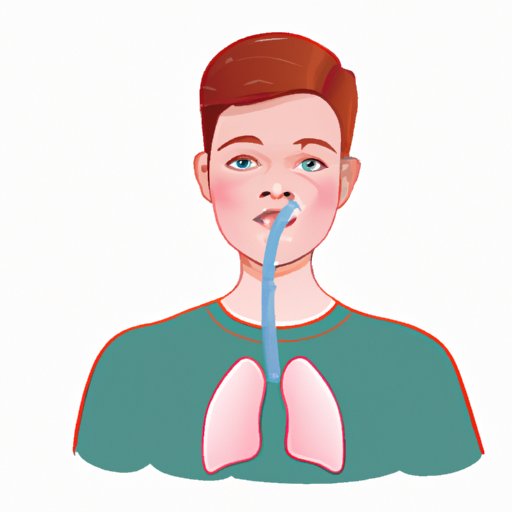
I. Introduction
Tracheostomy refers to the surgical procedure of creating an opening through the neck to create an opening in the windpipe called a tracheostomy, to help an individual breathe. A tracheostomy may be necessary in situations when the normal airway is obstructed or compromised, such as in cases of extended mechanical ventilation, severe neurological, or pulmonary disease. While tracheostomies provide an alternative means of breathing, individuals who undergo this procedure face many complex challenges, both physical and emotional. This article will explore how long you can live with a tracheostomy and provide useful tips for living with a tracheostomy.
II. Life After a Tracheostomy: Understanding Long-Term Prognosis
The life expectancy of an individual with a tracheostomy varies from case to case and depends on multiple factors. These include the underlying condition, the severity of respiratory and mobility limitations, and the ability of the individual to adapt to living with a tracheostomy. In general, with proper care, the life expectancy of someone with a tracheostomy can be relatively normal.
However, there are still potential complications that can arise. Those with mobility limitations may be at greater risk of developing pressure sores or other injuries. Tracheostomy patients may also face a higher risk of lung infections, particularly if they have underlying respiratory issues such as Chronic Obstructive Pulmonary Disease (COPD). Additionally, tracheostomy patients may require longer-term care, including end-of-life care, if their condition worsens. It is important for tracheostomy patients to discuss these potential outcomes with their medical team and plan accordingly.
III. Managing Life with a Tracheostomy: Tips for Living Your Best Life
For those living with a tracheostomy, there are several tips and strategies that can help maintain good health and a good quality of life. One essential aspect is maintaining optimal hygienic conditions. Tracheostomy patients must clean their tracheostomy site daily to prevent infection. Additionally, using a humidifier and saline solution, in collaboration with the medical team, helps to maintain optimal moisture levels to prevent complications arising from mucus and secretion buildup.
The importance of symptom and complication management cannot be overstated. In particular, managing secretions, coughing, and shortness of breath are significant factors affecting the day-to-day life of tracheostomy patients. To deal with these facts, individuals are recommended to explore various symptom management techniques such as breathing exercises, changing positions during coughing, or using devices such as mechanical cough assist machines. Consultation with an experienced medical team can provide valuable recommendations and guidance regarding management techniques that would be suitable for the patient’s condition.
Finally, engaging in social activities is important for patients to maintain emotional and mental well-being. Patients with tracheostomies may have trouble speaking, so it is essential to have communication tools such as voice-assistive or text-to-speech devices. Furthermore, patients can explore social media platforms or attend face-to-face support groups with fellow tracheostomy patients to share experiences, gain insights on adapting to life with a tracheostomy and also communicate effectively with their caregivers and loved ones.
IV. Tracheostomy: Understanding the Benefits and Risks
Tracheostomies are typically performed in emergency or intense surgery scenarios when the patient’s condition is life-threatening. They provide an alternate pathway for air to enter the lungs when the normal airway is blocked or unequipped to perform its duties, such as during extended periods of ventilator support. In such cases, a tracheostomy can support long-term ventilation when placed over more extended periods.
While it serves as a vital airway, tracheostomy placement involves the risks inherent in anesthesia, surgery, and medical equipment. Some potential risks include failure to oxygenate, loss of speech ability, the risk of infection, and bleeding. Individual complications, such as air leaking around the tube or blockages, can also occur and require immediate attention from the medical team.
V. Long-Term Care for Tracheostomy Patients: Tips for Patients and Caregivers
Tracheostomy tubes must be changed and cleaned regularly to avoid infections. The frequency will depend on the patient’s condition, and relatives or caregivers need to learn the necessary skills and techniques for safe tube management. Usually, the care team will provide support during the tube’s first change and also demonstrate and provide written instructions for the family on how to change the tracheostomy tube hygienically, including selecting to change the tube with specific airway equipment. Caregivers should also know how to manage secretions and mucus, understand their risk factors, and be able to identify and respond to potential complications of infections or tube blockages.
VI. Living with a Tracheostomy: Real-Life Stories and Experiences
Many people are living with a tracheostomy for various reasons. Tracheostomy patients are heroes, and they face unique experiences that require strength and determination to manage. Reading about true, first-hand stories of patients who are thriving with a tracheostomy can offer an insight and inspiration to other patients, caregivers, and medical teams. Real-life experiences offer the opportunity to learn from others and to realize that though caring for someone with a tracheostomy is daunting, it is possible with adequate training and support. It is essential to note that each patient’s experience is unique, and their outcomes may vary depending on their medical condition and the care provided.
VII. Conclusion
Living with a tracheostomy can be a challenging journey, both physically and mentally, as the patients adjust to a new reality. However, patients can manage these challenges effectively with proper nutrition, hygiene practices, and symptom management techniques. Patients, caregivers, and medical teams should work together to ensure that each patient has a customized care plan that suits their unique situation. Caregivers and medical teams should understand the concerns of tracheostomy patients and work with them towards a positive life experience. Seeking support and resources from peers or support groups and educational programs can help tracheostomy patients and their loved ones cope better, leading to a better quality of life for the patient overall.





